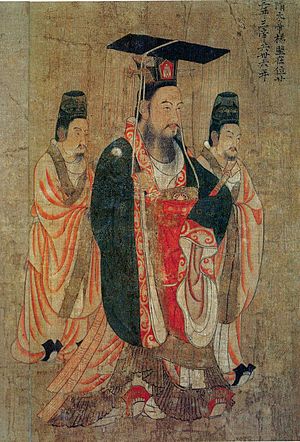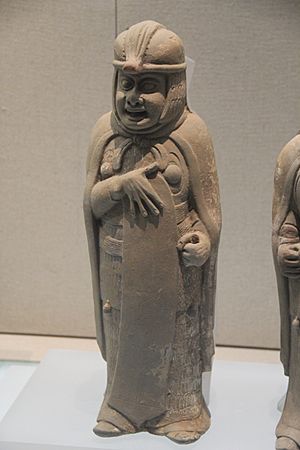Emperor Wen of Sui facts for kids
Quick facts for kids Emperor Wen of Sui隋文帝 |
|||||||||||||||||
|---|---|---|---|---|---|---|---|---|---|---|---|---|---|---|---|---|---|

Tang dynasty portrait of Emperor Wen by Yan Liben
|
|||||||||||||||||
| 1st Emperor of Sui Dynasty | |||||||||||||||||
| Reign | 4 March 581 – 13 August 604 | ||||||||||||||||
| Successor | Emperor Yang | ||||||||||||||||
| Born | 21 July 541 Chang'an, Western Wei |
||||||||||||||||
| Died | 13 August 604 (aged 63) Renshou Palace, Baoji, Sui China |
||||||||||||||||
| Consorts | Empress Wenxian | ||||||||||||||||
| Issue | Yang Yong Emperor Yang Yang Jun Yang Xiu Yang Liang Princess Leping Princess Xiang Princess Guangping Princess Lanling Princess Wanan Yang Zhong |
||||||||||||||||
|
|||||||||||||||||
| Father | Yang Zhong | ||||||||||||||||
| Mother | Empress Yuanming | ||||||||||||||||
Emperor Wen of Sui (born Yang Jian, 楊堅) was a very important emperor in Chinese history. He founded the Sui dynasty and became its first emperor. He was born on July 21, 541, and passed away on August 13, 604.
Emperor Wen is famous for bringing China back together in 589. Before him, China had been divided for centuries. He also started building the famous Grand Canal, a huge waterway that connected different parts of China. He was a Buddhist and encouraged the spread of Buddhism across the country. His reign was a time of great wealth and strength for China.
Contents
Early Life and Family Connections
Yang Jian's father, Yang Zhong, was an important general in the Western Wei and Northern Zhou dynasties. Yang Jian was born in a Buddhist temple in Pingyi, which is in modern-day Weinan, Shaanxi. A Buddhist nun helped raise him when he was very young.
Yang Jian went to a special school for children of important families. When he was 14, he joined the military. In 555, because of his father's achievements, Yang Jian received important titles.
Marriage and Rise to Power
In 557, when Yang Jian was 16, he married Dugu Qieluo, who was 13. Her father, Dugu Xin, was a powerful general who was impressed by Yang Jian. This marriage connected Yang Jian to a very influential family.
Later that year, Yang Jian became a high-ranking official. As time went on, he gained more military power. In 573, Yang Jian's daughter, Yang Lihua, married the Crown Prince Yuwen Yun, who later became Emperor Xuan of Northern Zhou. This made Yang Jian the emperor's father-in-law, giving him even more influence.
Some people, like Emperor Wu's brother and a general named Wang Gui, were worried about Yang Jian's growing power. They thought he might try to take over. Yang Jian tried to hide his abilities to avoid trouble. However, he still played a big part in Emperor Wu's successful wars against the rival Northern Qi state.
Challenges with Emperor Xuan
In 578, Emperor Wu died, and Yuwen Yun became Emperor Xuan. Emperor Xuan was not a stable ruler. Even though he made Yang Jian's daughter his empress, he deeply mistrusted Yang Jian. He even threatened Yang Jian's family at one point. Yang Jian had to be very careful to avoid being harmed.
Becoming Regent
In 580, Emperor Xuan became very ill. Two of his close friends, Liu Fang and Zheng Yi, who were also friends with Yang Jian, called Yang Jian to the palace. They wanted him to become the regent, meaning he would rule for the young emperor. Emperor Xuan soon died, and Yang Jian was officially named regent.
Yang Jian quickly made many good changes. He stopped the wasteful and harsh rules of Emperor Xuan. He worked hard and lived simply, which made people respect him.
Putting Down Rebellions
A general named Yuchi Jiong, who was far from the capital, did not trust Yang Jian. He thought Yang Jian wanted to take the throne for himself, so he started a rebellion. Other generals joined him.
Yang Jian sent his own generals to fight Yuchi Jiong. After 68 days, Yuchi Jiong was defeated and took his own life. Other rebellions were also quickly put down. To make sure the city of Yecheng, where Yuchi Jiong had his base, could not be used against him again, Yang Jian had it torn down.
During these rebellions, some members of the royal family tried to harm Yang Jian, but they failed. After Yuchi Jiong was defeated, Yang Jian removed the Yuwen family, the former ruling family, from power. He quickly gained more titles and power.
Around the beginning of 581, Yang Jian was given the title Prince of Sui. In the spring of 581, he had the young Emperor Jing give up the throne to him. This ended the Northern Zhou dynasty and started the new Sui Dynasty, with Yang Jian as Emperor Wen. He chose "Sui" as his dynasty's name, which was his old title.
Early Years of the Sui Dynasty
Emperor Wen made many important changes to the government. He created new departments and agencies to run the country more smoothly. He honored his parents as emperor and empress. He made his wife, Duchess Dugu, the empress, and their oldest son, Yang Yong, the crown prince. He also gave his brothers and other sons important titles.
He gave important government jobs to trusted officials like Gao Jiong, Yang Su, and Su Wei. He also sent his sons to lead important provinces, giving them a lot of power. Emperor Wen also simplified the laws, making them less harsh, which was a big improvement for the people.
Dealing with Neighboring Groups
Emperor Wen did not want to be controlled by the Göktürks, a powerful group to the north. The Göktürk leader, Ashina Helu, and his wife, Princess Qianjin (who was from the former Northern Zhou royal family), were angry at Emperor Wen for ending the Northern Zhou dynasty. They attacked Sui's borders.
To deal with this, Emperor Wen used a clever plan. He encouraged different Göktürk leaders to fight among themselves. This made the Göktürks unable to work together against Sui. By 584, Ashina Helu submitted to Sui, and even Princess Qianjin accepted Emperor Wen as a powerful ruler.
Building a New Capital
In 582, Emperor Wen decided that the old capital, Chang'an, was too small. He built a new capital city nearby called Daxing. In 583, the capital was moved to Daxing. This new city was much larger and better planned.
He also started building canals to make it easier to transport food and supplies. The Guangtong Canal, built in 584, helped bring food to the capital region. Later, in 587, the Shanyang Canal was built to connect the Yangtze River and the Huai River, improving trade and transport.
Unifying China
Emperor Wen had been planning to conquer the Chen Dynasty, which ruled the southern part of China, for many years. In 588, he publicly announced his campaign against Chen. His sons, Yang Guang and Yang Jun, along with general Yang Su, led the attack.
In 589, Sui armies crossed the Yangtze River. They quickly defeated the Chen forces and captured the Chen emperor, Chen Shubao. Emperor Wen treated the captured emperor and his family well. With this victory, the long period of division in China ended, and the Sui Dynasty united the entire country. Just as he had torn down Yecheng, Emperor Wen also had the Chen capital, Jiankang, torn down.
Later Years of the Sui Dynasty
After conquering Chen, Sui applied its laws to the new southern territories. This caused some unhappiness among the wealthy families in the south, who had enjoyed special treatment before. There were some rebellions, but Emperor Wen sent general Yang Su to put them down, which he did quickly.
Changes in Government and Society
In 592, Emperor Wen reduced taxes greatly because there was so much food and silk stored in government warehouses. He also sent officials to redistribute land to poor farmers, helping them to grow their own food.
He also built a summer palace called Renshou Palace. It was very grand, more luxurious than Emperor Wen expected, and its construction was difficult.
In 595, Emperor Wen ordered that private citizens could not own weapons, and all weapons had to be collected and destroyed. This helped keep the peace, though border areas were allowed to keep some weapons for defense.
Dealing with Rebellions and Challenges
In 597, some local tribes rebelled, but Emperor Wen sent generals to put down these uprisings. He also made punishments for official misconduct and theft much stricter, though he later changed the theft punishment.
His son, Yang Jun, the Prince of Qin, became very ill due to his wife, Princess Cui. When Yang Jun was brought back to the capital for treatment, Emperor Wen found out that Yang Jun had been wasteful. He removed Yang Jun from his official positions and ordered Princess Cui to leave the family.
Succession Challenges
Emperor Wen's oldest son, Yang Yong, was the Crown Prince. However, he lost favor with both Emperor Wen and Empress Dugu because he was wasteful and had many wives. They began to think about replacing him with his younger brother, Yang Guang.
In 599, Yang Guang and general Yang Su worked together to make it seem like Yang Yong was planning against the emperor. Emperor Wen removed Yang Yong from his position as Crown Prince and made Yang Guang the new Crown Prince.
Final Years and Passing
In 602, Empress Dugu passed away, which made Emperor Wen very sad. After her death, he spent more time with his other wives, Consort Chen and Consort Cai.
In 604, Emperor Wen became ill while staying at Renshou Palace. He passed away in the fall of that year. He was buried in the Tailing mausoleum, alongside Empress Dugu.
Emperor Wen's reign was a time of great change and progress for China. He reunited the country, improved its government, strengthened its military, and started major building projects like the Grand Canal. He is remembered as one of China's most important emperors.
Family
Emperor Wen had several children with his wife, Empress Wenxian:
- Princess Leping (561–609)
- Princess Xiang
- Yang Yong, Prince of Fangling (568–604)
- Yang Guang, Emperor Yang (569–618)
- Princess Guangping
- Yang Jun, Prince Xiao of Qin (571–600)
- Yang Xiu, Prince of Shu (573–618)
- Princess Lanling (573–604)
- Yang Liang, Prince of Han (575–605)
See also
 In Spanish: Emperador Wen de Sui para niños
In Spanish: Emperador Wen de Sui para niños


